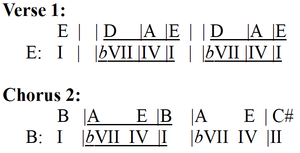|
I started the analytical (as opposed to the introductory) part of the blog yesterday with a structural analysis of “Whole Lotta Love”. In it, I implied that early Zeppelin songs illustrate how they grew out of their predecessors like The Beatles. That is true to a certain extent, but that's not entirely true. I oversimplified a bit. Of course there are exceptions. And as evidence to the contrary, I present a structural analysis of “Good Times Bad Times”, the opening number of Zeppelin's 1968 self-titled debut album, which has a unique (to my knowledge, anyway) formal design. Get a load of this oddity!: Okay, so, the first thing to notice is that there are two distinct verses, here labeled Verse A and Verse B. While The Beatles occasionally employed multiple different verses within the same song (check out “Glass Onion” or “Lovely Rita”), it's rare. I don't know other bands' oeuvres well enough to cite a non-Beatles example off the top of my head, but I'm sure there are examples to be found. Some scholars have debated with me over the justification for using multiple verses instead of other labels. “Rita”, for example, is often analyzed as using verses and bridges instead of multiple verses. I certainly see the point, but I maintain these are all verses for reason I won't get into here. In any case, “Good Times” definitely uses multiple verses because each section in question is paired with a chorus – exactly what would be expected of verses. The second thing that stands out is that the chorus also has two different iterations. The distinction here is harmonic: The first and third choruses are in A major, while the second is in B major. This middle chorus grows organically out of what was heard in the first chorus as it adds an E chord (IV) on the third beats of the second and fourth measures, circled red in the example below. This addition results in a double plagal cadence (A-E-B, bVII-IV-I, underlined below) from the second to third measures. This ties in to the harmony of the initial verse (shown in the example below), which also employs double plagals but in E major (D-A-E) and twice as long (four measures where the same pattern in the chorus lasts only two). Also, the middle chorus elucidates the tonality of the outer choruses. The first and third choruses are harmonically ambiguous on their own – are they really in A major? We don't necessarily have enough information to make that claim - there are no cadences to confirm such a conclusion. But the addition of those double plagals in the middle chorus implies that the harmony of the first and third can be interpreted as “incomplete double plagal cadences” which are missing the IV chord. With that in mind, we can indeed infer that the outer choruses are in A major.
One last thing about the choruses: The middle iteration is abbreviated. While the first and third choruses both feature a two-bar bass transition, the second chorus omits it. This further differentiates the choruses, which strengthens the eventual conclusion (see below) that "Good Times" is a compound ternary structure. Finally, the solo replaces a verse. It employs identical harmonies, but rhythmically halved. This, too, grows organically out of what preceded it. The solo also uses double plagal cadences, just like the first verse and second chorus. It uses the tonality of the verse's double plagals (D-A-E) but with the chorus's rhythms (two measures instead of four). So the solo is related to both the first verse (through tonality) and to the second chorus (through rhythm). The overall structure of “Good Times Bad Times”, then, is a hybrid AB|CB'|A'B – it's part compound simple (an AB x3 in which the middle AB is actually a CB') and part compound ternary (ABA'). If I had to pick one of those designations, I think the latter more accurately and precisely articulates the form. Even though this song is from Zep's first album, it shows a spectacularly advanced hybrid formal structure and organic development that breaks with their predecessors' work (to the extent of my knowledge). It certainly would not be the last time they would use such a sophisticated musical design.
0 Comments
Your comment will be posted after it is approved.
Leave a Reply. |
Aaron Krerowicz, pop music scholarAn informal but highly analytic study of popular music. Archives
August 2019
Categories
All
|



 RSS Feed
RSS Feed
